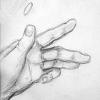Actually, if you have troubles using Pen+Mouse, try Pen+Space Navigator. That is the ultimative combination for 3D Work, especially sculpting, but the Space Navigator also works fine in Blender.
While all Space Mice are kinda expensive (3DConnexion has no competition at the moment, meaning they can charge whatever people are ready to pay... and the CAD Pros can pay a lot it seems), the basic versions are in the not-too-expensive category at around 125 bucks (at least here in Switzerland).
Takes some time to get used to, but then you will never ever use your Mouse again for navigation in 3D Space...
On topic, I am a humble Programmer myself, but do a lot of art too as I am developing on my own at the moment (and really like to draw and sculpt). I splashed out the lofty sum needed for a Wacom Cintiq 24HD at christmas 2 years ago and it was one of the best investments in my life.
If you draw a lot digitally, do 3D Sculpting or other stuff like that, there is no way around a Pen Tablet. And if you have just a little bit of artistic talent like me, but lack the time and expierience to learn to draw with a mouse or even just do the Hand-Eye coordnation stuff needed for a "normal" Tablet (like the intuos series), a pen tablet screen like the cintiq will really take your artistic work to the next level.
I know there are a lot of Mouse Users out there that will say something different. For me, its clear: I really like my cintiq!












